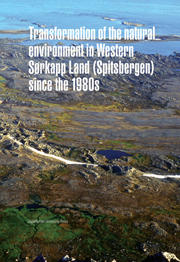Book contents
- Frontmatter
- Contents
- Introduction
- Study area
- Methods and materials
- Components of natural environment
- Environmental and landscape changes
- Climate warming
- Glacial recession
- Transformation of landforms and Quaternary deposits
- Changes of water drainage and networks
- Changes in vegetation
- Conclusions and prognosis for environmental change
- References
- List of enclosures (maps)
- Plate-section
Glacial recession
from Environmental and landscape changes
Published online by Cambridge University Press: 05 September 2014
- Frontmatter
- Contents
- Introduction
- Study area
- Methods and materials
- Components of natural environment
- Environmental and landscape changes
- Climate warming
- Glacial recession
- Transformation of landforms and Quaternary deposits
- Changes of water drainage and networks
- Changes in vegetation
- Conclusions and prognosis for environmental change
- References
- List of enclosures (maps)
- Plate-section
Summary
Snow patches, permafrost and glaciers are the environmental components most sensitive to climate warming.
All the snow patches melt during the warmest and sunniest summer seasons across western Sørkapp Land lowlands and mountains, except for the patch, where the Lisbetelva river originates. In spite of climate warming, there are still summer seasons with numerous snow patches that last until the next winter season. Permafrost is more isolated from the summer heat (positive temperatures) by a layer of ground, which thaws down to a certain depth, i.e. the so-called active layer. In spite of the lack of a detailed survey, an increase in the active layer's thickness has been observed. Its maximum thickness in Quaternary deposits (apart from blocks and boulders) varied between 40 cm and 1.5 m, according to their granulation and vegetation, at sites below 100 m of altitude in 1986 (Ziaja 1988), and had doubled by in 2008. Rapid melting of thin (up to 2 m) ice lenticels occurs in rare pingo landforms in the lowest marine terrace (Fig. 9).
Glaciers react to warming with a few years (or longer) delay. Almost all Sørkapp Land glaciers have undergone a continuous recession since the beginning of the 20th century (Ziaja 1999; Błaszczyk et al. 2009). Only three small glaciers in the highest part of the Hornsundtind mountain group increased in thickness (and volume) from the 1930s to the 1980s (Ziaja 1999), but then became smaller as well.
- Type
- Chapter
- Information
- Transformation of the Natural Environment in Western Sorkapp Land (Spitsbergen) since the 1980s , pp. 51 - 60Publisher: Jagiellonian University PressPrint publication year: 2011



